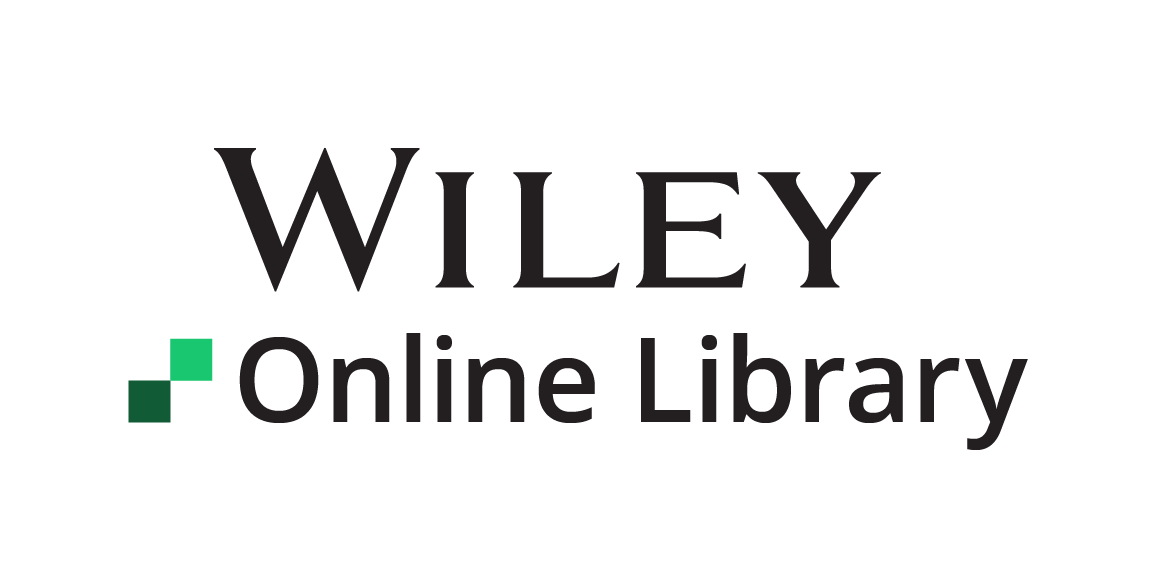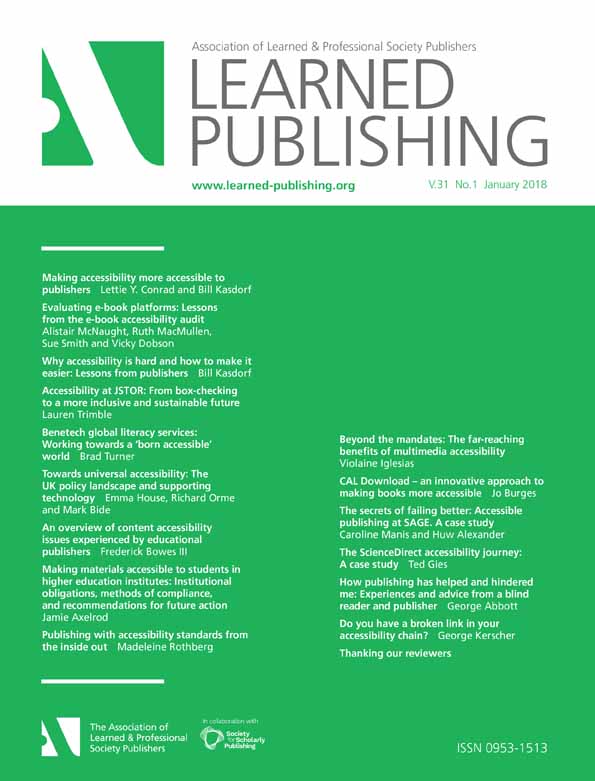Making accessibility more accessible to publishers
Accessibility is no longer a fringe topic: We must ensure access to all end-to-end publishing systems and products.
Some of the most profound perspectives shared in this special issue on accessibility in scholarly publishing come from the first-person viewpoint. Taking a moment to consider the information experiences of those with physical, learning, or cognitive disabilities illuminates the reason Learned Publishing dedicated this issue to addressing why and how our community can better serve these needs.
We are inspired by the groundswell of industry awareness of the human realities of inaccessible publications, as seen in conference proceedings and webinar programmes across the publishing landscape. We are encouraged by leaps of progress in technical opportunities and data standards, such as EPUB and Web Accessibility (http://apexcovantage.com/blog/accessible-publishing-just-got-easier-get-right/) – offering publishers clearer guidance towards a faster, more efficient means to produce and disseminate resources that are born accessible as well as upgrading existing publications and software products. Our industry is now acknowledging that accessible publishing is aligned with our core mission to broadcast research and information to all our constituents, as well as realizing that making publications accessible makes them better for everybody. We are impressed by new collaborative approaches to accessibility, such as the Big Ten's Standardized Accessibility License Language (https://www.btaa.org/library/accessibility/library-e-resource-accessibility---standardized-license-language) and the harmonization of international specifications and guidelines, such as those from the US Access Board (https://www.access-board.gov/guidelines-and-standards/communications-and-it/about-the-ict-refresh/overview-of-the-final-rule) and the European Commission (http://ec.europa.eu/ipg/standards/accessibility/index_en.htm). The growth of such initiatives underscores the obligation we share with university libraries to serve disabled readers of all kinds. And we are motivated by new legislative requirements, such as the recently ratified Marrakesh Treaty (http://www.wipo.int/treaties/en/ip/marrakesh/summary_marrakesh.html) and the support mechanisms (http://www.wipo.int/edocs/mdocs/copyright/en/sccr_35/sccr_35_3-executive_summary1.pdf) being put in place to ensure we achieve our vision for accessible publishing.
Accessibility awareness is on the rise in our industry due to the eloquence of champions like George Abbott, Director of the American Foundation for the Blind Press since 2013, who shares his story in ‘How publishing has helped and hindered me: Experiences and advice from a blind reader and publisher’. Our awareness extends to the on-the-ground realities of those who serve disabled readers on college campuses, as demonstrated by Jamie Axelrod in making materials accessible to students in higher education institutions: institutional obligations, methods of compliance, and recommendations for future action, and the need for not just publications but the modes of accessing them to be accessible, as discussed by George Kerscher in ‘Do you have a broken link in your accessibility chain?’
This special issue is rich with expert guidance for publishers – our very own Bill Kasdorf provides unique insights and original findings from his work with international publishers as they implement accessible publishing workflows. Long-time accessibility consultant, Rick Bowes offers solutions to common publisher pain-points in reaching content accessibility compliance. Brad Turner, Benetech's Vice President of Education, provides an inspirational overview of their innovative business models that support a suite of products and services that both enable access and elevate accessible publishing practices.
Publishing associations and content-industry collectives are also turning a great deal of attention to supporting our ability to fully serve the accessibility community. Alistair McNaught leads a group of Jisc members who offer original insights into how ebooks have the potential to serve as assistive technology and greatly extend advantages to all readers. Experts at the UK Publishers Association offer here a comprehensive digest of relevant international standards and mandates that all publishers must be aware of in order to further their accessibility strategies.
While accessibility standards are more concrete and actionable than ever before, we are not lacking in debate or inconsistencies. As scholarly publishing gets even more complex, so do the needs for accessibility and related requirements for the production and presentation of our publications. Madeleine Rothberg, with the National Center for Accessible Media at WGBH, provides an overview of accessible publishing standards and how EPUB is poised to replace PDF as the standard accessible publication delivery format. As part of her analysis of a recent survey on accessible video, Violaine Iglesias from GPVi discusses the value of working with multimedia standards to ensure that non-text resources are accessible and allow for user interactivity.
This issue demonstrates that the barriers to accessible publishing are coming down, and the return on investment is on the rise. While we must fit accessible practices into already complicated workflows, we must still prioritize remediation amongst other competing priorities as well. Ted Gies at Elsevier is quite familiar with the work necessary to enhance an existing platform to meet accessibility protocols. His piece, ‘The ScienceDirect accessibility journey: A case study’, offers some important perspectives on the return on investment in accessibility and highlights important operational lessons to be learned. Lauren Trimble illuminates similar experiences at JSTOR, which has demonstrated that it is possible to achieve a modern, efficient, and accessible digital programme. SAGE's accessible ebooks are also an excellent case in point. As Huw Alexander and Caroline Mannis explain, the journey to accessible publishing requires patience in traversing an accessible ebook publishing roadmap. And Jo Burges offers an example of how collaborative partnerships and cutting-edge technology can accelerate that journey.
Accessibility is no longer a fringe topic on the margins of the academic publishing ledger. Instead, publishing in a manner that is accessible to all is central to our purpose. We must all engage in and contribute to ensuring that publishing workflows lead to fully accessible works and begin to extend our thinking to ensure access to all end-to-end publishing systems and products. The good news is: It's easier now than it ever has been. So, let's get to work!




